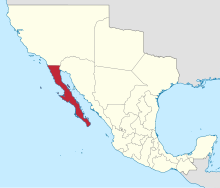Woolly sculpin
| Woolly sculpin | |
|---|---|

| |
| Scientific classification | |
| Domain: | Eukaryota |
| Kingdom: | Animalia |
| Phylum: | Chordata |
| Class: | Actinopterygii |
| Order: | Scorpaeniformes |
| Family: | Cottidae |
| Genus: | Clinocottus |
| Species: | C. analis
|
| Binomial name | |
| Clinocottus analis (Girard, 1858)
| |
The woolly sculpin (Clinocottus analis) is a species of fish in the family Cottidae, one of the families of sculpins. It is known commonly as charrasco lanudo in Spanish.[1] It is native to the eastern Pacific Ocean, where it occurs along the coastline of California and Baja California.[1]
Description
This fish reaches up to 18 centimeters in length.[1] Their characteristic elongated and speckled body ends with a large wide and flattened head.[2] Their eyes are found on the top of their head perpendicular to their large mouth aligned with many teeth.[2] They are scaleless, instead, they have gills covering their large spine ending in a pair of sharp spines.[2] They have dorsal, anal and caudal fins, each with 12 to 15 rays.[2] The caudal fin is rounded and darker than the rest of their body.[2]

Ecology and metabolism
This species lives on the seabed of intertidal waters up to 18 meters deep.[1] It is commonly found in tide pools amidst algaes, but it leaves the tide pool area at will.[1] It can breathe air and has been known to survive out of water for up to 24 hours.[3]
Habitat
They are commonly found near the sand, small rocks and bedrock, specially in intertidal areas at near 19 m.[2] They are found in water temperature ranges between 6ºC and 22ºC.[2] They are able to survive rapid temperature fluctuations and rapid changes in salinity.[2]
Predators
In the United States is depredated by the greaat blue heron (Ardea herodias), Leucophoyx thula i Catoptrophorus semipalmatus[4]
Feeding
The diet of this species includes mainly crustaceans, especially amphipods, as well as fish eggs and larvae, polychaetes, and molluscs.[2] Most of its food items are light-colored or clear, suggesting that these are easiest for the fish to see against the dark background of its habitat.[5]
Reproduction
Their reproduction is oviparous with internal fertilization and spawning occurs in shallow coastal waters. Each female lays several batches of 50 to 1,300 eggs multiple times per year.[2] These have a size ranging between 12 to 25 mm, settling the larvae in the tide-pools. In a few months, they mature to a length of 50-60 mm in total.[6]
Behavior
They are non-migratory species.[2] They can camouflage themselves due to their subtle changes in body color.[2] Their mottled specks are green, greenish-black, greenish-brown and reddish covering their body as well as their fins.[2] The fins are also colored according to their body color patterned with light thin bands.[2]
Supplementary information

They are harmless to humans.[7]
The population dynamics of Clinocottus analis is highly seasonal. In general, growth and fertility peak from early spring to summer. However, survival is not seasonal.[6]
This fish has green blood plasma, the color caused by biliverdin tightly bound in protein complexes.[2]
References
- ^ a b c d e Froese, R. and D. Pauly, Eds. Clinocottus analis. FishBase. 2015.
- ^ a b c d e f g h i j k l m n o "Woolly Sculpin". Mexico - Fish, Birds, Crabs, Marine Life, Shells and Terrestrial Life. 2017-02-08. Retrieved 2022-11-25.
- ^ Martin, K. L. (1991). Facultative aerial respiration in an intertidal sculpin, Clinocottus analis (Scorpaeniformes: Cottidae). Physiological Zoology 64(5) 1341-55.
- ^ "Predators - Clinocottus analis". fishbase.mnhn.fr. Retrieved 2022-11-25.
- ^ Mollick, R. S. (1970). Food habits of Clinocottus analis (Girard).[permanent dead link] California Fish and Game Volume 56 133-134.
- ^ a b Davis, Jld; Levin, La (2002). "Importance of pre-recruitment life-history stages to population dynamics of the woolly sculpin Clinocottus analis". Marine Ecology Progress Series. 234: 229–246. doi:10.3354/meps234229. ISSN 0171-8630.
- ^ "Clinocottus analis, Woolly sculpin". www.fishbase.de. Retrieved 2022-11-25.
External links
- Woolly Sculpin (Clinocottus analis). Photo Gallery: Natural History of Orange County, California and Nearby Places. School of Biological Sciences. University of California, Irvine.
Further reading
- Cook, A. (1996). Ontogeny of feeding morphology and kinematics in juvenile fishes: A case study of the cottid fish Clinocottus analis. The Journal of Experimental Biology 199, 1961–71.
